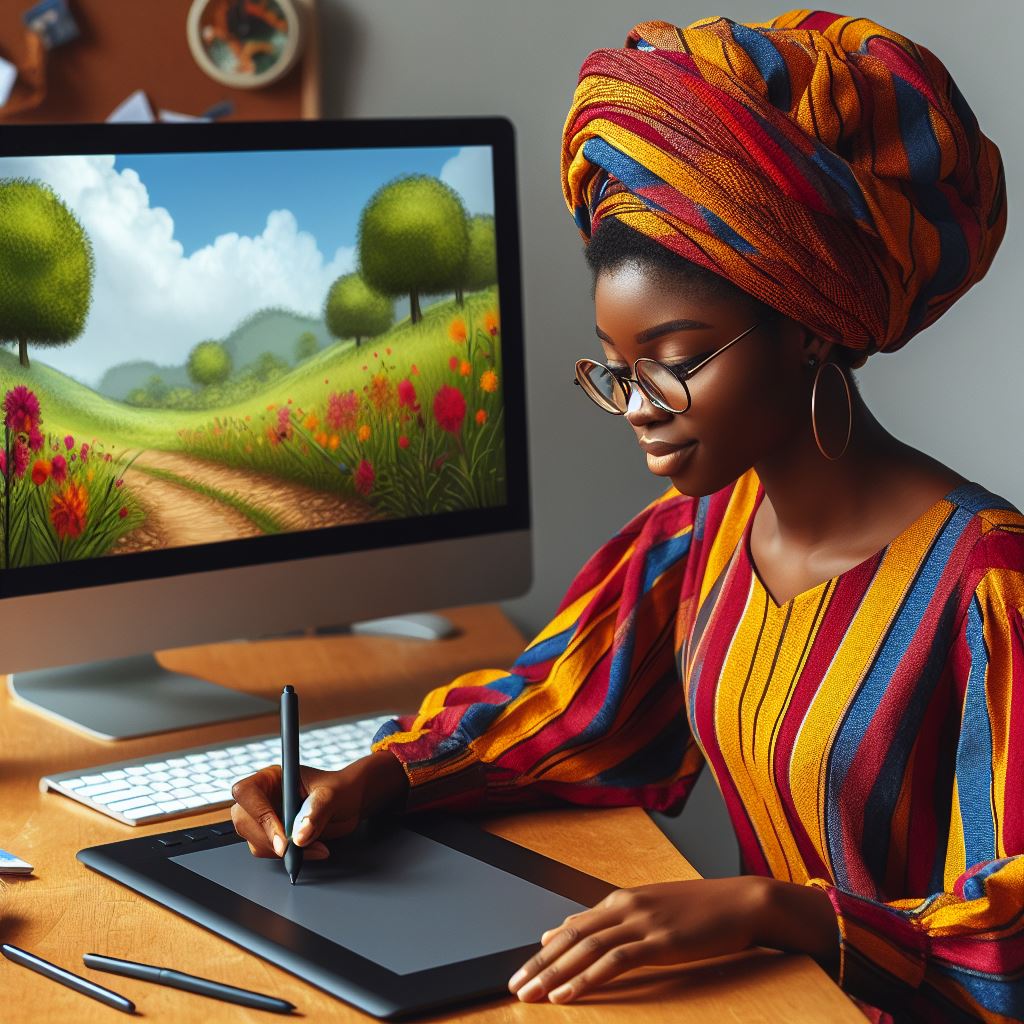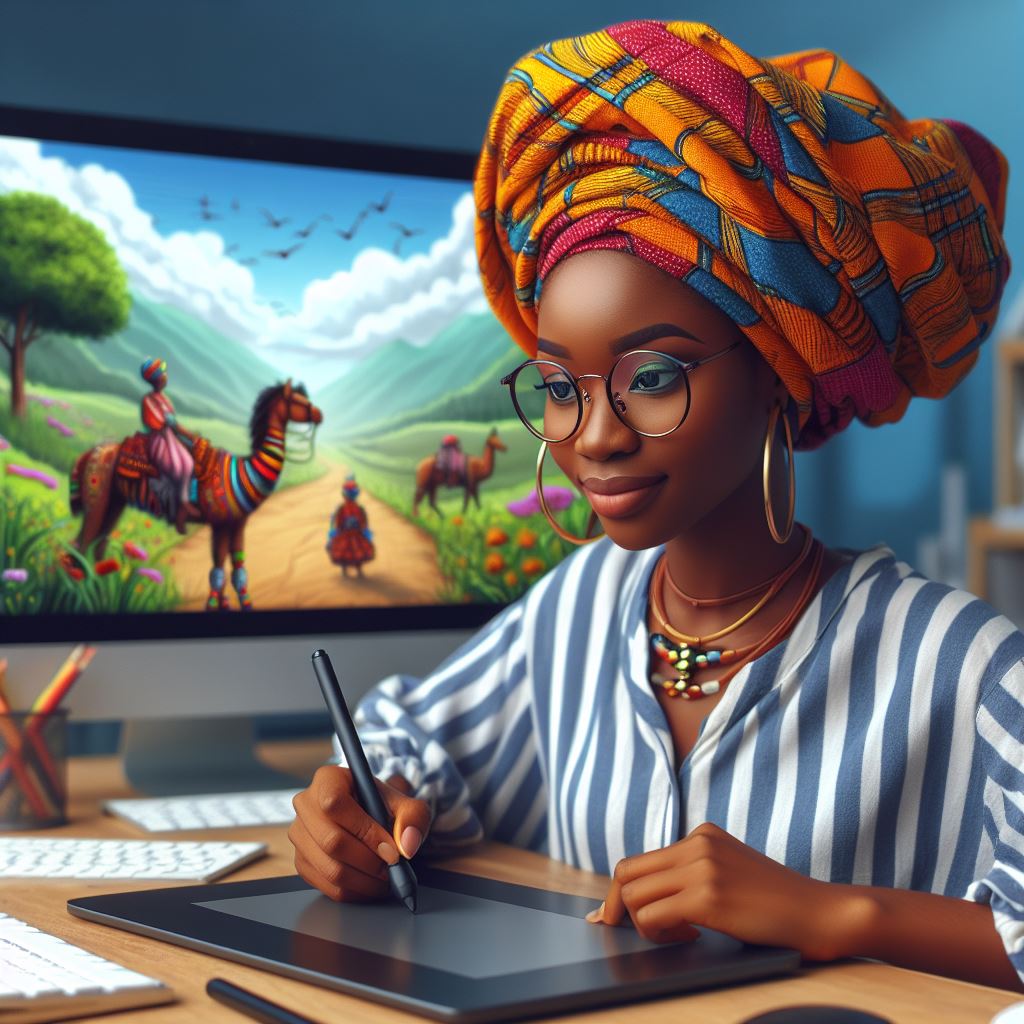Introduction
The infusion of technology into Nigerian visual arts has brought about a profound transformation, redefining both the creation and consumption of artistic expressions.
With a heritage steeped in centuries-old traditions, Nigerian visual arts encompass a rich tapestry of cultural influences, from ancient sculptures to vibrant contemporary paintings.
Throughout history, Nigerian artists have drawn inspiration from their cultural heritage, incorporating elements of folklore, mythology, and societal themes into their works.
However, the advent of technology has introduced new tools, techniques, and mediums, expanding the possibilities for artistic innovation and expression.
Studying the impact of technology on Nigerian visual arts is essential for understanding the ever-evolving nature of artistic practices and the broader cultural landscape.
It offers insights into how technology shapes artistic processes, influences artistic narratives, and fosters new modes of artistic engagement.
By delving into this fascinating realm, we gain a deeper appreciation for the resilience, creativity, and dynamism of Nigerian visual arts in the digital age.
Through exploration and analysis, we uncover the intricate ways in which technology serves as both a catalyst for innovation and a bridge between tradition and modernity in Nigerian artistic expression.
Traditional Techniques vs. Modern Technology
Traditional Techniques in Nigerian Visual Arts
Nigerian visual arts have long relied on traditional techniques such as sculpture, painting, and textile weaving.
These methods have deep roots in cultural heritage and reflect diverse regional influences.
Modern Technology’s Influence on Traditional Techniques
However, modern technology has revolutionized these traditional techniques, offering new avenues for artistic expression.
Digital tools like graphic design software, 3D printing, and virtual reality have transformed the creative process.
For example, traditional sculptors now use digital sculpting software to design intricate pieces with precision and efficiency.
Painters experiment with digital painting techniques, blurring the line between traditional and digital art forms.
Examples of Artists Embracing Technology in Their Artwork
Renowned Nigerian artist, Victor Ehikhamenor, incorporates digital elements into his mixed-media artworks, exploring themes of identity and globalization.
His use of digital photography and collage techniques creates visually stunning and thought-provoking pieces.
Similarly, textile artist Nike Davies-Okundaye merges traditional weaving techniques with digital printing technology to produce vibrant textile designs.
Her innovative approach showcases the fusion of tradition and modernity in Nigerian visual arts.
Furthermore, the collective, “Rele Arts Foundation,” hosts an annual exhibition called “Tech Meets Art,” where artists showcase innovative artworks that integrate technology.
These exhibitions serve as platforms for artists to experiment with new techniques and push the boundaries of artistic expression.
In summary, the impact of technology on Nigerian visual arts is profound and far-reaching.
While traditional techniques remain integral to artistic practice, modern technology offers exciting possibilities for innovation and experimentation.
By embracing technology, Nigerian artists continue to redefine the boundaries of artistic expression and contribute to the dynamic evolution of visual arts in Nigeria.
Read: Comparing Communication Arts and Mass Communication
Access to Global Markets
Technology’s Role in Reaching a Larger Audience
The advent of technology has significantly transformed the landscape of Nigerian visual arts, revolutionizing the ways in which artists create, share, and engage with their work.
Traditionally confined by geographical constraints, Nigerian artists now have the ability to reach a global audience through digital platforms and online galleries.
By leveraging digital tools and online platforms, artists can showcase their artwork to viewers worldwide, breaking down barriers and expanding their reach beyond Nigeria’s borders.
This newfound accessibility has enabled Nigerian artists to share their unique perspectives, stories, and cultural heritage with a diverse global audience, fostering greater appreciation and understanding of Nigerian visual arts on an international scale.
Social Media’s Impact on Promoting Nigerian Visual Arts
Social media platforms have emerged as powerful tools for promoting Nigerian visual arts internationally.
Platforms such as Instagram, Twitter, and Facebook provide artists with unprecedented opportunities to showcase their work, connect with fellow artists and collectors, and engage with a global community of art enthusiasts.
Through strategic use of hashtags, targeted marketing campaigns, and engaging content, Nigerian artists can effectively amplify their presence and reach on social media, attracting followers and garnering attention from art lovers around the world.
The visual nature of social media platforms allows artists to showcase their artwork in vivid detail, captivating audiences with stunning visuals and compelling narratives.
Success Stories of Nigerian Artists on a Global Scale
Numerous Nigerian artists have achieved remarkable success and recognition on a global scale through the power of technology.
One such success story is that of Njideka Akunyili Crosby, whose intricate mixed-media paintings exploring themes of identity and cultural hybridity have garnered widespread acclaim.
Through social media platforms and online galleries, Crosby has been able to showcase her work to a global audience, exhibiting in prestigious institutions and galleries worldwide.
Similarly, visual artist Laolu Senbanjo gained international recognition for his “Afromysterics” art style, which blends traditional Yoruba motifs with contemporary influences.
Senbanjo’s collaboration with Beyoncé on the visual album “Lemonade” catapulted him into the international spotlight, further amplifying his reach and influence on the global art scene.
Furthermore, the emergence of online art marketplaces such as Artsy and Saatchi Art has provided Nigerian artists with unprecedented opportunities to showcase and sell their work to collectors worldwide.
Artists like Peju Alatise and Victor Ehikhamenor have successfully leveraged these platforms to expand their international presence and connect with art enthusiasts from diverse cultural backgrounds.
Essentially, technology revolutionizes the Nigerian visual arts scene, enabling artists to gain global recognition beyond geographical boundaries.
Through social media promotion, online galleries, and digital marketplaces, Nigerian artists make significant strides in the international art world.
Read: Language Arts Courses: What to Expect in Nigeria
Innovation and Experimentation
Technology’s Role in Encouraging Innovation and Experimentation
Technology has served as a catalyst for innovation and experimentation in Nigerian visual arts, sparking new creative possibilities and pushing the boundaries of artistic expression.
Artists are embracing digital tools and techniques to explore innovative approaches and reimagine traditional practices.
Utilization of Digital Tools and Software in Art Creation
The emergence of digital tools revolutionizes the artistic process, granting artists unprecedented flexibility and freedom in creativity.
With access to digital painting software and 3D modeling programs, artists bring their visions to life efficiently and precisely.
Showcasing Examples of Nigerian Artists Pushing Boundaries with Technology
Nigerian artists are harnessing the power of technology to push boundaries and explore new techniques in their artwork.
For instance, photographer Lakin Ogunbanwo manipulates and enhances his photographs using digital editing software, creating captivating, surreal imagery.
Similarly, multimedia artist Olalekan Jeyifous incorporates digital rendering techniques into his architectural designs, blurring the lines between art and architecture.
His innovative use of technology allows him to create immersive and thought-provoking installations that engage audiences on multiple levels.
Furthermore, mixed-media artist Ken Nwadiogbu utilizes digital collage techniques to craft visually striking compositions addressing social and political issues.
By combining traditional and digital elements, Nwadiogbu pushes the boundaries of artistic expression and challenges conventional notions of art-making.
Essentially, technology empowers Nigerian visual artists to embrace innovation, push artistic boundaries, and redefine contemporary art possibilities.
Using digital tools, artists explore new techniques, push creative boundaries, and create captivating works resonating globally and locally.
Read: Internship Opportunities for Communication Arts Students

Preservation of Cultural Heritage
Technology’s Contribution to Preserving Cultural Heritage
Technology has become instrumental in safeguarding Nigeria’s rich cultural heritage through visual arts, offering innovative solutions for documentation, preservation, and dissemination of traditional art forms.
Utilization of Digital Archives and Virtual Museums
Digital archives and virtual museums play a crucial role in documenting and showcasing traditional Nigerian art forms to a global audience.
These platforms provide accessible and immersive experiences, allowing users to explore artifacts and artworks from Nigeria’s diverse cultural heritage.
Importance of Using Technology for Safeguarding Cultural Artifacts
The utilization of technology is paramount in safeguarding Nigeria’s cultural artifacts and traditions for future generations.
By digitizing cultural artifacts, researchers and scholars can study and analyze them without risking damage to the originals.
Furthermore, virtual exhibitions and online repositories ensure cultural heritage accessibility to a broad audience, transcending geographical boundaries.
This democratization of access promotes cultural exchange and understanding, fostering appreciation and preservation of Nigeria’s cultural diversity.
Therefore, technology serves as a powerful tool for preserving Nigeria’s cultural heritage through visual arts.
By leveraging digital archives, virtual museums, and innovative preservation techniques, Nigeria safeguards its cultural artifacts, inspiring future generations globally.
Read: Impact of Communication Arts on Nigerian Media
Collaboration and Networking
Technology has revolutionized the way Nigerian visual artists collaborate with their counterparts globally.
Through various digital tools and platforms, artists can now connect, communicate, and work together regardless of geographical barriers.
Illustrating Global Collaboration
- Virtual collaboration tools like Zoom and Skype have made it easier for Nigerian artists to collaborate with artists from different parts of the world.
- Artists can now share ideas, techniques, and even work on joint projects without the need for physical presence.
- This has expanded the creative horizons of Nigerian artists, exposing them to new perspectives and approaches to art.
Impact of Online Platforms
- Online platforms such as social media, artist communities, and virtual galleries have played a significant role in connecting artists worldwide.
- These platforms provide a space for artists to showcase their work, engage with a global audience, and receive feedback and critique from other professionals.
- Virtual events like online exhibitions and art fairs have also become popular, allowing artists to participate and showcase their work without having to travel.
Benefits of Networking through Technology
- Networking through technology offers Nigerian visual artists numerous career growth opportunities.
- By connecting with other artists, curators, collectors, and experts in the industry, artists can learn, collaborate, and expand their professional network.
- Online workshops, webinars, and courses provide avenues for continuous learning and skill development for artists looking to enhance their craft.
- Networking through technology also opens up avenues for collaborations, partnerships, and mentorship opportunities that can propel artists to new heights in their careers.
Technology has transformed Nigerian visual arts, enabling collaborations, fostering creativity through online platforms, and providing networking opportunities.
Advancements in technology have connected Nigerian artists, breaking down barriers and opening new possibilities for artistic expression.
Conclusion
The infusion of technology into Nigerian visual arts has catalyzed a transformative shift, redefining traditional practices and expanding artistic horizons.
Digital tools and online platforms have democratized access to artistic resources and global audiences, fostering a culture of innovation and collaboration.
However, this digital revolution is not without its challenges.
The digital divide persists, limiting access to technology and hindering the full participation of some artists.
Moreover, concerns about authenticity and cultural preservation emerge as technology blurs the boundaries between traditional and digital art forms.
In navigating this evolving landscape, Nigerian artists find themselves at the intersection of tradition and modernity.
As they harness the power of technology to express their unique perspectives, they forge new paths forward, enriching the cultural tapestry of the nation.
In closing, the future of Nigerian visual arts in the digital age is both promising and complex.
By embracing technological advancements while remaining grounded in their cultural heritage, Nigerian artists are poised to leave an indelible mark on the global art scene, shaping narratives and inspiring creativity for generations to come.




